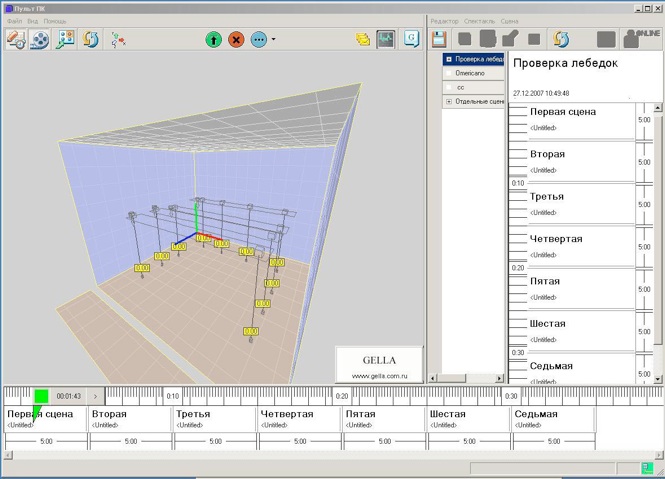Independently from the type of inter-winch connection (Ethernet or low-speed noise-immune G-net network) the server coordinates both internal and external processes, as well as provides an user interface and integrating capabilities (USB and RS-232 connection).
G-net
G-net network can be built with random topology via a Cat 5 cable with 4 twisted pairs -- one for transmitting the data in RS-485, and the other for a power device controller(12V DC).
Two channels of a simple symmetrical microphone cable can be used as segments of the G-net network with the simple cable adaptors when necessary (e.g., for connecting the control panels on stage).
The network can use long wires lines up to 1 km and more, given the common montage principles are obeyed. The proprietary network protocol provides improved noise immunity and self-testing feature. The speed of the network is lowered to 19200 bit/sec which allows to ensure more stable work in the noisy environment. For convenience, each G-net device has 2 ports for a fast daisy chain connection.
All the devices in the networks are equal in terms of their ability to directly send the data to other parts of the network. A dedicated network managing device provides special dispatching functions, such as search, log, workload control, timing and network ID service. According to the TIA/EIA-485-A specification, G-net supports up to 128 devices simultaneously connected to the network. The guaranteed time of the receiving the message package in the network of 32 devices is 0.3 sec (typically - 0.1 sec).
Two channels of a simple symmetrical microphone cable can be used as segments of the G-net network with the simple cable adaptors when necessary (e.g., for connecting the control panels on stage).
The network can use long wires lines up to 1 km and more, given the common montage principles are obeyed. The proprietary network protocol provides improved noise immunity and self-testing feature. The speed of the network is lowered to 19200 bit/sec which allows to ensure more stable work in the noisy environment. For convenience, each G-net device has 2 ports for a fast daisy chain connection.
All the devices in the networks are equal in terms of their ability to directly send the data to other parts of the network. A dedicated network managing device provides special dispatching functions, such as search, log, workload control, timing and network ID service. According to the TIA/EIA-485-A specification, G-net supports up to 128 devices simultaneously connected to the network. The guaranteed time of the receiving the message package in the network of 32 devices is 0.3 sec (typically - 0.1 sec).
Ethernet
If the corresponding option is installed, Miclift devices can use 10/100 Base-T Ethernet on a standard Cat 5 cable network. This allows to create large configurations, reduce the command response delays and easily integrate winches and other devices into technological networks. The network topology is standard for the TCP-IP protocols with conventional switches and routers. In the Ethernet configuration, the server becomes a gateway with two independent 10-Mbit ports.

Software
The software is based on a network daemon run on Linux OS on the compact platform supporting G-net and TCP-IP, as well as RS-232 interfaces. The program dispatches packets of different segments, stores the set-ups and settings information, as well as provides network coherence and integration options.
The server runs the web interface, allowing the user to interact with the winches through any computer connected to the system through Ethernet or WiFi with the standard browser supporting WebSocket technology. It can be modified for specific requirements just like any other website.
Integration options: standard MQTT or low-level proprietary protocol.
